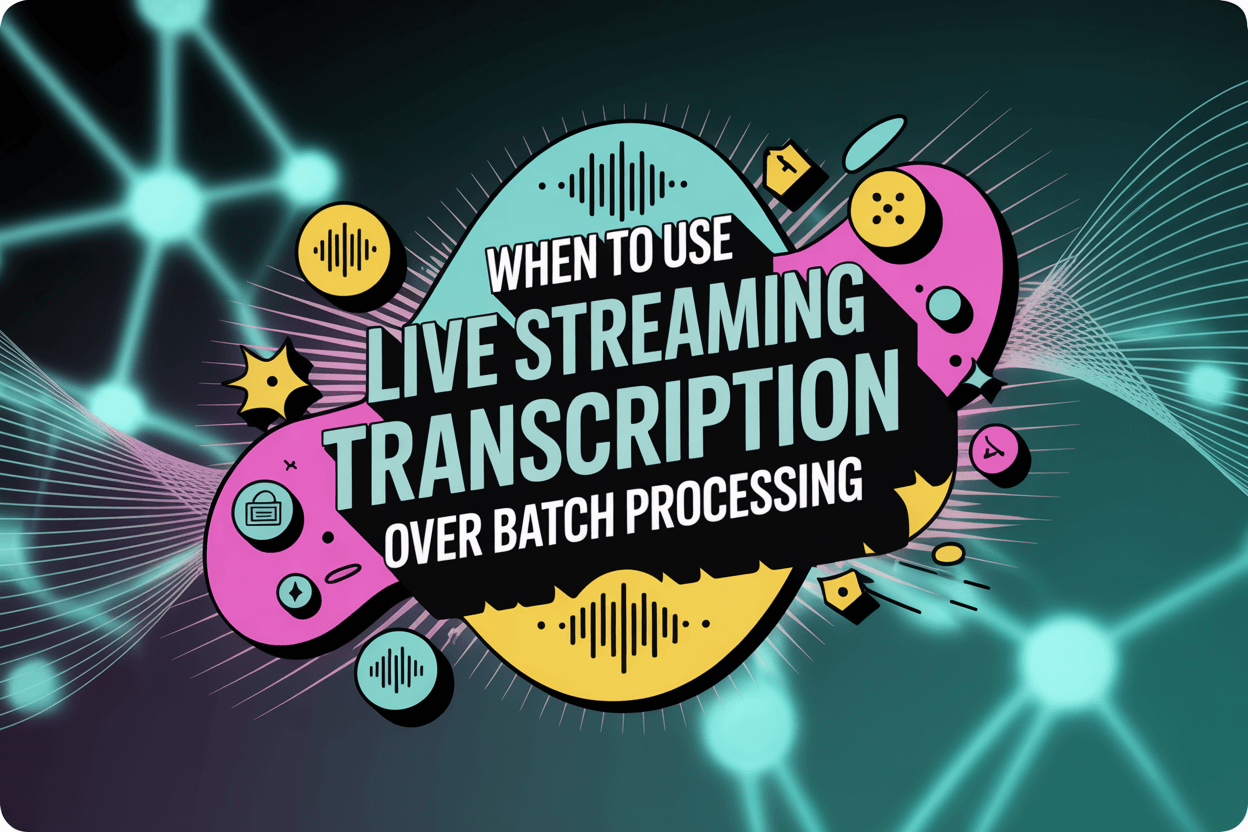Si consiglia di utilizzare trascrizione in diretta streaming quando è necessario produrre testo in tempo reale, ad esempio durante riunioni dal vivo, webinar o trasmissioni. Trascrizione dell'elaborazione in batch, è invece la soluzione migliore per i file preregistrati che possono essere elaborati dopo un evento. La scelta giusta dipende dall'importanza accesso immediato o accuratezza post-evento.

Che cos'è la trascrizione in diretta streaming?
Trascrizione in diretta streaming converte le parole pronunciate in testo mentre vengono pronunciate. Utilizza modelli di riconoscimento vocale in tempo reale che acquisiscono, elaborano e visualizzano il testo in pochi secondi. Ciò è particolarmente utile quando i partecipanti o gli spettatori hanno bisogno di didascalie o note immediate.
🔸 Casi d'uso comuni
- Webinar dal vivo ed eventi virtuali
- Formazione e lezioni online
- Chiamate di assistenza clienti in diretta
- Didascalie di accessibilità in tempo reale
La trascrizione in tempo reale aiuta i team a rimanere impegnati e informati all'istante. Tuttavia, poiché privilegia la velocità, può essere leggermente meno accurata dei metodi batch, soprattutto in ambienti rumorosi o con più interlocutori.
🧠 Che cos'è la trascrizione con elaborazione batch?
Trascrizione in lotti - nota anche come trascrizione asincrona o offline - elabora registrazioni audio o video dopo la sessione è completa. Invece di risultati immediati, il sistema analizza l'intero file prima di produrre una trascrizione, garantendo una migliore punteggiatura, accuratezza e separazione dei parlanti.
🔸 Casi d'uso comuni
- Trascrizione di podcast e interviste
- Archivio delle riunioni aziendali
- Registrazioni di ricerca accademica
- Conversioni di mediateche di grandi dimensioni
Questo metodo funziona meglio per i progetti in cui l'accuratezza, la formattazione e il contesto sono più importanti della velocità. È la soluzione ideale per le organizzazioni che gestiscono registrazioni lunghe o documentazione dettagliata.
⚙️ Live vs Batch: Differenze chiave da conoscere
| Caratteristica | Trascrizione in diretta streaming | Elaborazione in lotti Trascrizione |
|---|---|---|
| Velocità | Uscita istantanea e in tempo reale | Ritardato ma accurato |
| Precisione | Moderato | Superiore (consapevole del contesto) |
| Scalabilità | Ideale per le sessioni dal vivo | Ideale per le grandi biblioteche |
| Casi d'uso | Riunioni, webinar | Ricerca, post-produzione |
| Requisiti di Internet | Sempre richiesto | Può essere offline o basato su cloud |
In breve:
- Scegliere trascrizione dal vivo quando il tempismo è fondamentale.
- Scegliere trascrizione in batch quando la precisione e la scalabilità sono più importanti.
🚀 Utilizzo di VOMO.AI per la trascrizione live e batch
Se avete bisogno di uno strumento che supporti flussi di lavoro in tempo reale e batch, VOMO.AI è la scelta migliore. Il suo motore di trascrizione guidato dall'intelligenza artificiale è in grado di catturare le sessioni dal vivo, consentendo al tempo stesso caricamenti in blocco per l'analisi post-evento.
I team possono facilmente trascrivere interi archivi di riunioni, conferenze o interviste, mantenendo precisione e formattazione. Con VOMO.AI, gli utenti possono gestire sia da audio a testo e da video a testo conversioni in modo efficiente, sia in tempo reale che in modalità batch.
🎯 Quando si dovrebbe usare la trascrizione in live streaming?
Si consiglia di utilizzare trascrizione in diretta streaming quando:
- Il pubblico ha bisogno di sottotitoli o didascalie immediate.
- Volete l'accessibilità in tempo reale per gli utenti con problemi di udito.
- Avete bisogno di documentazione dal vivo per eventi, lezioni o conferenze.
- Avete intenzione di integrare l'output di testo con flussi video in diretta o chatbot.
Ad esempio, durante un webinar globale, la trascrizione in diretta garantisce che ogni partecipante possa seguire la discussione, indipendentemente dall'accento o dal rumore di fondo.
💼 Quando l'elaborazione in lotti è una scelta migliore?
Utilizzo trascrizione in batch quando si dispone di contenuti registrati che non richiedono didascalie dal vivo, ma che necessitano di un'immagine trascrizione pulita e accurata in seguito. Questo include podcast, interviste registrate o grandi archivi video.
L'elaborazione in batch è ideale quando:
- Avete ore di media da elaborare contemporaneamente.
- Avete bisogno di dati strutturati, timestamp o riepiloghi.
- Il vostro obiettivo è la documentazione, la conformità o l'analisi.
🧩 La scelta del giusto flusso di lavoro di trascrizione
L'approccio ideale dipende dal vostro flusso di lavoro:
- Per la velocità: Vai con trascrizione in diretta streaming.
- Per la precisione: Scegliere elaborazione in batch.
- Per la versatilità: Utilizzate piattaforme come VOMO.AI, che consentono di passare da una all'altra a seconda del progetto.
I moderni sistemi di intelligenza artificiale consentono persino configurazioni ibride: trascrizioni in diretta durante gli eventi, salvate automaticamente e perfezionate in un secondo momento attraverso la rielaborazione in batch per una maggiore precisione.
Pensieri finali
La scelta tra la trascrizione in live streaming e l'elaborazione in batch dipende dalle vostre esigenze. esigenze di tempistica, aspettative di accuratezza e dimensioni del carico di lavoro. Se si organizzano eventi dal vivo o riunioni virtuali, la trascrizione in tempo reale consente di mantenere la comunicazione senza interruzioni. Per l'archiviazione e la documentazione, la trascrizione in batch garantisce un risultato affidabile e curato.
Con soluzioni avanzate come VOMO.AI, Non è necessario scegliere l'uno piuttosto che l'altro: è possibile gestirli entrambi in modo efficiente in un unico luogo, garantendo una trascrizione rapida, accurata e scalabile per ogni caso d'uso.



